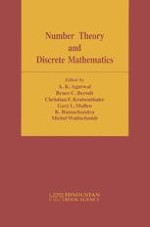2002 | Buch
Number Theory and Discrete Mathematics
herausgegeben von: Prof. A. K. Agarwal, Prof. Bruce C. Berndt, Prof. Christian F. Krattenthaler, Gary L. Mullen, K. Ramachandra, Prof. Michel Waldschmidt
Verlag: Hindustan Book Agency
Enthalten in: Professional Book Archive
